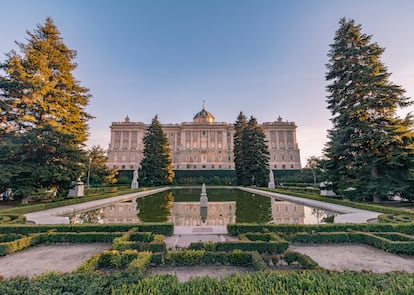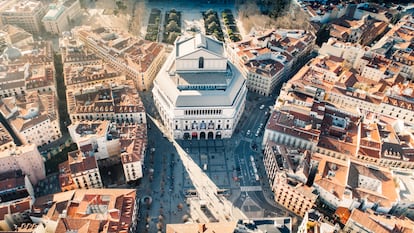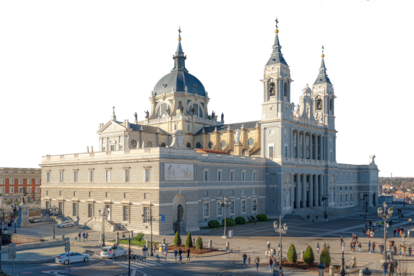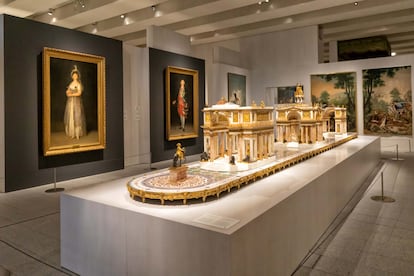In the center of the capital of Spain, a unique space that condenses centuries of history and art is opened. Real district of Madrid houses more than 400,000 square meters where palaces, gardens, monasteries, museums and experiences that announce the magnitude of the Spanish crown coexist. An identity hall of the city and a pride for Madrid. This cultural and tourist proposal has been created by the Community of Madrid, together with the Hotel Business Association of Madrid (AEHM), and the support of National Heritage and the Consistory of the capital. In addition, with the inauguration of the Gallery of the Royal Collections in 2023, the historical group has established itself as one of the most relevant cultural destinations in Europe.
The recent jewel tributes Spanish majesty
To meet Real District of Madrid, it is worth starting with the gallery of the royal collections, a building of contemporary lines that dialogues with the Royal Palace and the adjacent gardens of the Moorish field. The most ambitious museum project in Spain so far from the century highlights the artistic collection linked to the Spanish crown, the largest in the world that is preserved entirely. Of the 170,000 preserved pieces, a careful selection of 700 is exhibited in thematic rooms.
Among his most famous pieces are the Mühlberg armor (1544), forged by Desiderius Helmschmid for Carlos V; the crown of the Virgen de Atocha (1852), of the goldsmith Narciso Práxedes Soria; the polyptic of Isabel la Católica (1496-1504), by Juan de Flandes; the portraits of Carlos IV and María Luisa de Parma (1799), by Francisco de Goya; Black horse box (1634-1638), by Diego Velázquez, is a prodigy of realism and movement; or the flamenco tapestries woven on rubens cards.
Before leaving the building, it is worth contemplating the views from the gallery viewpoint, better if it can be at sunset when the light bathes the city of reddish tones.
Concluded the visit to the extraordinary collection, the Royal Palace of Madrid awaits the traveler. Built on the remains of the old Alcazar of the Austrias – as it for a fire in 1734 -, this real building was raised by Felipe V following the model of Versailles, a mixture of baroque and classic style, and predominance of large dimensions both inside and outside.

The largest Royal Palace in Europe today – with 135,000 square meters and 2,500 stays – was the official residence of the Kings until Alfonso XIII and today is used for state ceremonies. The visit allows rooms such as the throne hall, the royal chapel, the crown room or the main staircase, where they remain fresh, tapestry and historical furniture.
Madrid symbols of culture and recreation
The Royal Palace opens before the imposing Plaza de Oriente, a recreation symbol for Madrid living in the area and those who wish to walk through this framework of green areas guarded by the colossal equestrian sculpture of Felipe IV, the first of this type in the world. The square was conceived in the time of José Bonaparte and in front of it the Real Theater stands, opened in 1850. It is considered one of the most prestigious operatic temples in Europe, and its annual program attracts visitors from all over the world, although a guided margin can also be made.

The gardens of the Moorish field accompany the majesty of these buildings. A green space of 200,000 square meters behind the royal palace that receives its name from a medieval episode: Muslim troops camped in 1109 to try to reconquer Madrid. And on the north facade of the royal building, another recreation space, the Sabatini gardens. The old place where the real stables were located became the current example of neoclassical symmetry in 1935. Its central pond, surrounded by sculptures, is one of the most photographed places in the city, especially at sunset.
Where spirituality and art dialogue
The Real District Panoramic of Madrid is not understood without the Almudena Cathedral, in honor of the patron saint of Madrid, an eclectic -style building whose dome stands on the sky of the capital at 70 meters high. Consecrated in 1993 by Pope John Paul II, this temple was the result of more than a century of works. The museum and crypt complete their visit. And a few meters away, two not -so -known Madrid jewelry await the traveler: the monasteries of the incarnation and the real barefoot. The first saves baroque reliquaries and an imposing cloister; The second, retains Tiziano Rubens and paintings.

However, Real District of Madrid is not limited to passive contemplation. Every first Wednesday of the month, the Royal Guard held in the Plaza de la Armería – between the cathedral of La Almudena and the southern facade of the Royal Palace – a Solemn relief With 400 troops, horses and artillery, evoking the protocol of the nineteenth century. Other weekly guards are also celebrated in the Plaza de Oriente and concerts in the Royal Chapel.
The heart of Madrid beyond the capital
The Real District of Madrid is complemented by other national heritage enclaves, located outside the capital of Spain, less than an hour of displacement. The Royal Monastery of El Escorial, the Palacio de Aranjuez and the Royal Site of El Pardo form a historical triangle that tells monarchical history over Madrid articulated territory through power, art and nature. The first, declared a World Heritage for UNESCO, was Monastery, Pantheon and Political Center of Felipe II. Before this, Aranjuez’s building was the first Spanish cultural landscape recognized by the same institution. And finally, the Pardo Palace, surrounded by forests, is today residence of foreign state leaders when they visit Spain.
You can consult the Real District Guide of Madrid in these links: https://www.visitmadrid.es/ y https://aehm.es/

